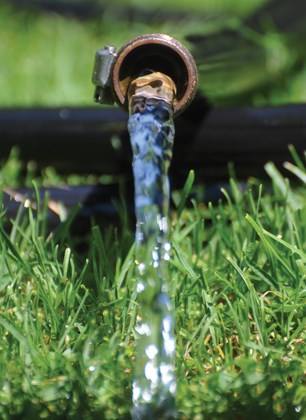Of all the skills I have taught students over the years, watering is one of the most difficult to learn.
Most people either overwater or underwater their potted plants and gardens. It’s not that people don’t understand the need to water, they don’t do the required follow-through to understand how much water is moving into the soil.
Here’s some advice to help with your garden watering this summer.
First, a few facts about water and soil that everyone should know: The deeper the water moves into the soil, the deeper plant roots will grow, assuming the soil is aerated enough for roots to grow down into the soil. Shallow watering produces shallow rooted plants, which are predisposed to drought stress.
Very dry soil will at first resist water infiltration until the soil absorbs some water to allow percolation, a condition known as hydrophobic. Water runs down into the soil in a loose pyramidal shape, which is why soaker hoses must be set close together to avoid dry spots in between the hoses.
Soil that has a diverse structure, including a range of particle size, ample organic matter, good pore space and healthy microorganisms, will absorb and hold water more efficiently than a homogenized soil.
Mulch allows water to percolate into the soil more efficiently than a soil that is not mulched. Mulch retains soil moisture and slows evaporation.
Potted plants should have enough water volume applied to assure that water drains from the bottom of the pot to adequately water most of the pot’s soil and to prevent fertilizer salt build up.
Watering restrictions in the Metro Vancouver region were only implemented to control watering of grass. Those restrictions only apply to lawns, not planting beds, veggies or potted plants, at least not yet.
Watering gardens in the evening or at night does not cause plant disease. In specific instances, some crops will suffer increased disease attack, usually in nurseries, greenhouses and other industrial crop production systems. But residential gardens have a different ecology and do not generally suffer increased disease growth.
When it comes to actually watering, automated irrigation systems are the most poorly understood and incorrectly used watering devices. Partially due to the fact that owners don’t do proper follow-through to assure that the system’s water sufficiently penetrates deep enough into the soil.
Many owners assume the irrigation system is functioning properly as long as the system comes on when programmed.
I can remember taking students from the University of British Columbia horticulture program to look at various landscape features in the condos and apartments around the campus. While we were walking around, we came upon an apartment complex that had its irrigation system running in early April. The weather was cool, watering was not needed and the entire landscape was being flooded by the system. Signs of overwatering were plentiful, including small leaf size, yellowing leaves, lack of growth and soil erosion.
Such occurrences are not as uncommon as you think. Irrigation systems are programmed on a timed schedule with little consideration for soil moisture levels or plant need. And there is the problem of how much volume is applied versus duration of operation with those systems. Yes newer systems come with rain, temperature and soil sensors. But most soil moisture sensors are sparsely installed across the range of the garden’s soils and not accurate for plant needs. And unless NASA builds the sensor, a $300 soil sensor is just not technically up to the job.
No matter the equation or technique used to water, follow through after watering to determine how deep the water has penetrated into the soil.
If you’re a longtime gardener, you will have learned your plant’s needs. However, I suggest digging a few holes around the garden after watering to see how much water actually absorbed into the soil.
To further help with garden watering here are a few guidelines to follow: Always mulch the soil to reduce water need and help retain soil moisture.
Water deeply to promote deep rooting to withstand drought. Morning or evening watering is fine. Evening watering also helps cool the house down. If water is running off the soil too quickly, stop watering, allow absorption, then restart and repeat as needed until the water infiltrates the soil. Established gardens, usually three to four years or older, will need watering during summer once every five to seven or 10 days depending on mulch depth and quality of soil.
A larger volume applied less frequently will produce deeper rooted plants versus watering frequently with less volume. Growing plants close together so they touch is called cover-cropping, not fornication, and cover-cropping reduces evaporative water loss from the soil. Happy watering!
Todd Major is a journeyman horticulturist, garden designer and builder, teacher and organic advocate. [email protected]



